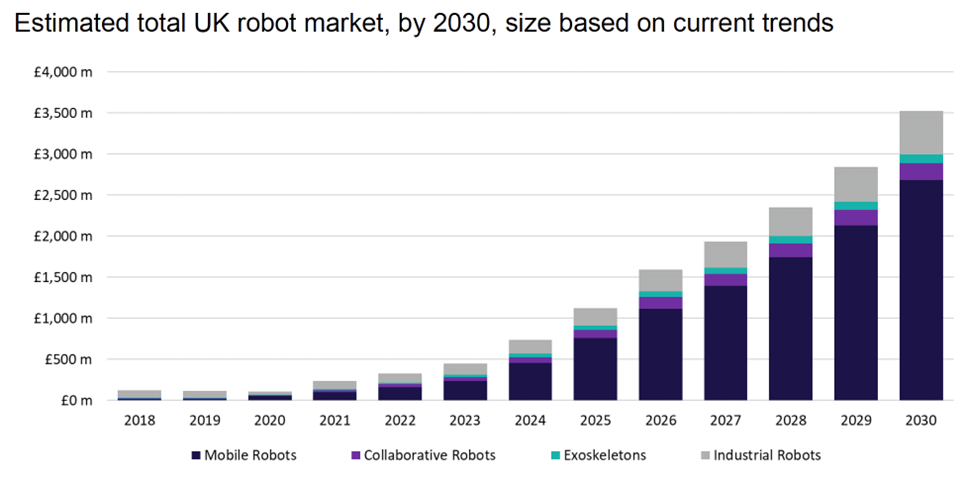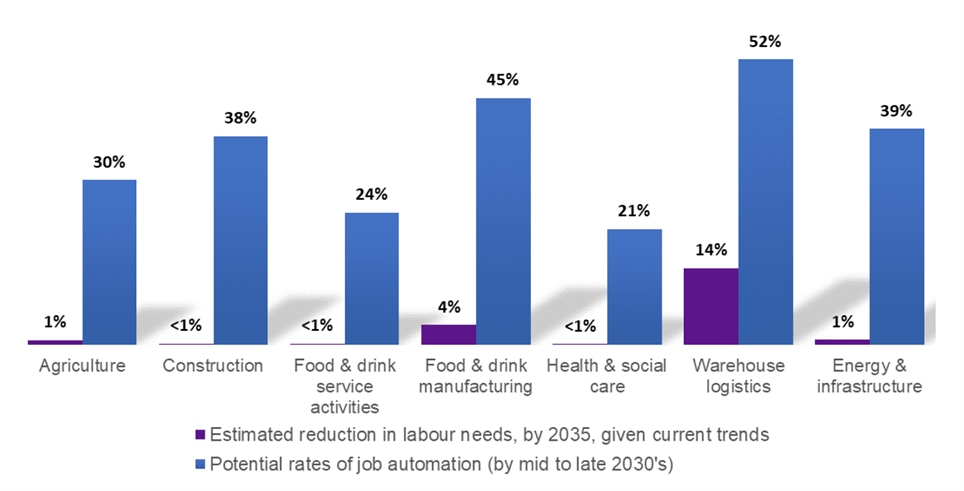Businesses are bearing the brunt as the UK economy battles to contain various pressures both at home and abroad. A weak pound, higher interest rates, increased energy costs, supply-chain issues and labour force shortages continue to create challenges, following the significant recent events of Brexit, COVID, and the war in Ukraine.
Owing to uncertainty around global supply chains and costs, some companies are looking closer to home, bringing manufacturing and logistics functions back to the UK.
Along with a current stretch on the availability of talent, one area of development starting to see shoots of uptake in the UK is the use of robots and autonomous systems.
Until now, UK businesses have failed to capitalise on the opportunities presented by automation with industrial robots in the UK. Recent research by Boston Consulting Group (BCG) (2019) suggests that there is a significant gap between the ambitions of companies to implement robots and the actual implementation of systems.
Adoption of robotics and automated systems in the UK
Based on ABI Research (2020) robot shipments forecasts, analysis suggests that the total UK market for robots and automated systems will grow at a compound annual growth rate of more than 40% annually between 2020 and 2030.

But the fact remains, productivity in the UK has been sluggish since 2008/09, and lower than many peer economies, such as the United States, Germany and France. In 2015, the UK had 10 robots for every million hours worked, compared with 131 in the US, 133 in Germany and 167 in Japan. By 2017, the UK represented just 0.6% of industrial robotics shipments*.
With current social trends of an ageing population and low birth rates in the UK, growth in labour productivity is essential. A recent study from Oxford Economics (2019) estimates that boosting robot installations to 30% above the baseline forecast by 2030 could lead to a 5.3% boost in global GDP (approx. $4.9 trillion per year by 2030).
This would mean an estimated impact of 15% of Gross Valued Added (GVA) in the UK – more than £200 billion – and a potential manufacturing sector productivity rise of up to 22%, generating long-term employment increases of up to 7% (cited by Special Interest Group Robotics and Autonomous Systems, 2014).
Robotics and autonomous systems are becoming increasingly crucial for the UK economy with far-reaching economic effects and the potential to bring significant opportunities for companies looking to reduce costs and/or improve efficiency.
Automation gap
Comparing the estimated levels of automation (by mid to late 2030s), given current adoption trends, and possible automation rates across highlighted sectors, the analysis points to a significant gap between estimated future automation trends and potential automation.

Are you ready for robots?
There are several reasons why UK PLC has been slow in the uptake of robotics. Many businesses see robots as expensive industrial machines for large installations on new production lines. Many also assume that robots require a high level of expertise to manage and operate.
The fact is, the ongoing development of robotic hardware and software has created a much more comprehensive range of solutions, including the introduction of systems designed to work safely alongside a workforce. Collaborate robots (cobots) are flexible robotic systems that can work safely in an environment with people. They are also much more flexible and can be re-programmed with intuitive interfaces and re-deployed depending on a company’s changing needs.
We have seen collaborative robots being used, not just in industry and production lines, but also in hospitality for serving food and mixing drinks, for camera work by the film industry and development tools for process and material research.
As the UK distributor for Techman Robots, we find ourselves having many open and honest conversations with companies looking to integrate robot technology into their business. While the information to implementation gap can be pretty significant, it is certainly closing fast.
If you would like to discuss the impact robots could have within your business, why not get in touch to see if you are ready?
Article adapted from BEIS Research Paper Number: 2021/043.

